Downloads
Executable for the map editor (Windows 32bits)
Executable for the game (Windows 32bits)
Before you try to compile the code go to the "Projects" tab on the left menu, select the "Run" settings for your kit,
and set the "Working directory" to the path of "editor\data" for the editor or "game\data" for the game.
Objects on the walls

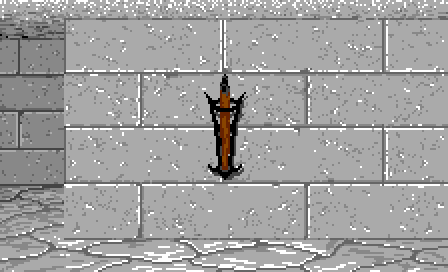
They have something in common: they both hold objects in a wall.
For now we only had objects on the ground. An obect stack is defined by its coordinates - the coordinates of the
quarter of tile where it lies.
If we want to put a stack of objects on a wall, we will need the coordinates of its tile and the side of the wall.
So let's add a side to CObjectStack:
class CObjectStack
{
[...]
CVec2 mPos;
EWallSide mSide;
[...]
};
- If the side is set to eWallSideMax, it will be a ground stack and the coordinates will be those of the quarter
of tile where it is. - If mSide is not equal to eWallSideMax, it will be the side of the wall and the coordinates will be those of the tile
where the wall is.
CObjectStack* addObjectsStack(CVec2 pos, EWallSide side);
CObjectStack* findObjectsStack(CVec2 pos, EWallSide side);
void removeObjectsStack(CVec2 pos, EWallSide side);
it to find a stack both by its coordinates and its side:
int CMap::findObjectsStackIndex(CVec2 pos, EWallSide side)
{
for (size_t i = 0; i < mObjectsStacks.size(); ++i)
if (mObjectsStacks[i].mPos == pos && mObjectsStacks[i].mSide == side)
return i;
return -1;
}
The alcove wall
<wall name="Alcove">
<image>Alcove.png</image>
<param type="enum" values="Arched;Square;Vi Altar">Type</param>
<param type="stack"/>
</wall>
- An arched alcove
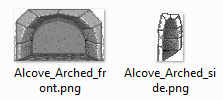
- A square alcove
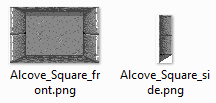
- And the Vi altar
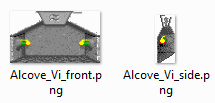
<ornate name="Alcove_Arched">
<image_front>Alcove_Arched_front.png</image_front>
<image_side>Alcove_Arched_side.png</image_side>
<pos_front x="64" y="69"/>
<pos_side x="34" y="69"/>
</ornate>
<ornate name="Alcove_Square">
<image_front>Alcove_Square_front.png</image_front>
<image_side>Alcove_Square_side.png</image_side>
<pos_front x="67" y="69"/>
<pos_side x="38" y="70"/>
</ornate>
<ornate name="Alcove_Vi">
<image_front>Alcove_Vi_front.png</image_front>
<image_side>Alcove_Vi_side.png</image_side>
<pos_front x="64" y="69"/>
<pos_side x="36" y="70"/>
</ornate>
We don't want to hardcode in the editor that the walls of type 5 holds a stack of objects, so we need this parameter.
But unlike the other parameters, like bool or int, it will not be associated to a value.
The stack will be stored along with the others and the coordinates of the wall will be sufficient to associate them.
Anyways we need this parameter to tell the editor to display specific buttons in the selection box.
Alcoves in the editor
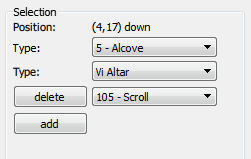
The first parameter is the type of alcove - arched, squared or Vi altar.
And the following buttons are exactly the same as an object stack, with buttons to "add" a new object, "delete" an object
in the list, and combo boxes to modify it's type.
The code is also similar to the ground stacks. In addWallParamsItems() we add the buttons to the selection box:
void CEditor::addWallParamsItems(uint8_t type)
{
[...]
std::vector<CParamType>& sourceList = map.mWallsParams[type];
for (size_t i = 0; i < sourceList.size(); ++i)
{
[...]
else if (sourceList[i].mType == eParamEnum)
{
CParamEnum* par = (CParamEnum*)param;
addLabel(wallSelGrid, sourceList[i].mName + ":", &mWallParamItems);
addComboBox(wallSelGrid, sourceList[i].mValues, &mWallParamItems, i, par->mValue);
}
else if (sourceList[i].mType == eParamStack)
{
CObjectStack* stack = map.findObjectsStack(pos, side);
size_t size = 0;
if (stack != NULL)
{
for (size_t i = 0; i < stack->getSize(); ++i)
{
addButton(wallSelGrid, "delete", &mWallParamItems, i);
addComboBox(wallSelGrid, bridge.itemsList, &mWallParamItems, sourceList.size() - 1 + i, stack->getObject(i).getType());
}
size = stack->getSize();
}
addButton(wallSelGrid, "add", &mWallParamItems, size);
}
}
}
void CBridge::setSelParamCombo(qint32 id, qint32 value)
{
[...]
else if (mTabIndex == eTabWalls)
{
CVec2 pos = editor.mSelectStart / TILE_SIZE;
EWallSide side = editor.getWallSideAbs(editor.mSelectStart);
CWall* wall = &map.getTile(pos)->mWalls[side];
bool isStack = false;
if ((size_t)id >= wall->mParams.size())
isStack = true;
else if (wall->mParams[id]->mType == eParamStack)
isStack = true;
if (isStack == true)
{
CObjectStack* stack = map.findObjectsStack(pos, side);
if (stack != NULL)
{
CObject& object = stack->getObject(id - (wall->mParams.size() - 1));
object.setType(value);
}
}
else
{
CParam* param = wall->mParams[id];
switch (param->mType)
{
SET_COMBO(eParamOrnate, CParamOrnate)
SET_COMBO(eParamEnum, CParamEnum)
default:
break;
}
}
}
[...]
}
void CBridge::selButtonClicked(qint32 id)
{
if (id == -1)
return;
if (mTabIndex == eTabObjects)
{
[...]
}
else if (mTabIndex == eTabWalls)
{
CVec2 pos = editor.mSelectStart / TILE_SIZE;
EWallSide side = editor.getWallSideAbs(editor.mSelectStart);
CObjectStack* stack = map.findObjectsStack(pos, side);
if (stack == NULL || (size_t)id == stack->getSize())
{
// add new object
if (stack == NULL)
stack = map.addObjectsStack(pos, side);
CObject object;
stack->addObject(object);
}
else
{
// remove object
stack->removeObject(id);
if (stack->getSize() == 0)
map.removeObjectsStack(pos, side);
}
// update the buttons
QMetaObject::invokeMethod(this, "updateSelStack", Qt::QueuedConnection);
}
}
Alcoves in the game
to draw the objects.
We draw them in CGame::drawWall():
else if (wall->getType() == eWallAlcove)
{
//------------------------------------------------------------------------------
// alcove
int type = wall->getEnumParam("Type");
walls.drawOrnate(image, tablePos, side, ORNATE_ARCHED_ALCOVE + type);
if (tablePos.y > 0 && side == eWallSideUp)
{
objects.drawObjectsStack(image, mapPos, playerSide, tablePos);
if (tablePos == CVec2(2, 3) && mouse.mObjectInHand.getType() != 0)
{
CRect rectLeft(CVec2(66, 84), CVec2(157, 124));
mouse.addArea(eMouseAreaG_DropObject, rectLeft, eCursor_Hand, (void*)mapPos.x, (void*)mapPos.y, (void*)playerSide);
}
}
}
We draw the objects by calling the drawObjectsStack() function that I modified to take into account the side of the wall
and the fact that the coordinates are those of a tile, not a quarter of tile.
void CObjects::drawObjectsStack(QImage* image, CVec2 mapPos, EWallSide side, CVec2 tablePos)
{
[...]
CObjectStack* stack = map.findObjectsStack(mapPos, side);
if (stack != NULL)
{
for (size_t i = 0; i < stack->getSize(); ++i)
{
int type = stack->getObject(i).getType();
if (type != 0)
{
// get object image
[...]
// get object position and add a pseudo random value
CVec2 pos;
if (side == eWallSideMax)
pos = getObjectPos(tablePos);
else
pos = getAlcovePos(tablePos);
[...]
// compute the scale based on the reference position (the nearest)
CVec2 pos0, pos1;
float scale;
if (side == eWallSideMax)
{
pos0 = getObjectPos(CVec2(WALL_TABLE_WIDTH, (WALL_TABLE_HEIGHT - 1) * 2));
pos1 = getObjectPos(CVec2(WALL_TABLE_WIDTH, tablePos.y));
scale = (float)(pos1.x - 112) / (float)(pos0.x - 112);
}
else
{
static float scalesTable[] = {0.36, 0.53, 0.82};
scale = scalesTable[tablePos.y - 1];
}
// scale the object in a temporary image
[...]
// darken the object based on it's distance
float shadow;
if (side == eWallSideMax)
shadow = ((WALL_TABLE_HEIGHT - 1) * 2 - tablePos.y) * 0.13f;
else
shadow = ((WALL_TABLE_HEIGHT - 1) * 2 - tablePos.y * 2) * 0.13f;
graph2D.darken(&scaledObject, shadow);
// draw the object on screen
[...]
// add the mouse area
if (mouse.mObjectInHand.getType() == 0)
{
bool isAreaOK = false;
if (side == eWallSideMax)
{
if (tablePos.x >= WALL_TABLE_WIDTH - 1 && tablePos.x <= WALL_TABLE_WIDTH)
{
if (tablePos.y == (WALL_TABLE_HEIGHT - 1) * 2 ||
(tablePos.y == (WALL_TABLE_HEIGHT - 2) * 2 + 1 && isWallInFront() == false))
{
isAreaOK = true;
}
}
}
else
{
if (tablePos.x == WALL_TABLE_WIDTH / 2 && tablePos.y == WALL_TABLE_HEIGHT - 1)
isAreaOK = true;
}
if (isAreaOK)
{
CRect mouseRect(pos, CVec2(pos.x + scaledObject.width() - 1, pos.y + scaledObject.height() - 1));
mouse.addArea(eMouseAreaG_PickObject, mouseRect, eCursor_Hand, (void*)stack, (void*)i);
}
}
}
}
}
}
CVec2 CObjects::getAlcovePos(CVec2 tablePos)
{
CVec2 pos;
pos.x = 250 * (tablePos.x * 2 - 4) / (8.5 - tablePos.y * 2) + 112;
static int yTable[] = {91, 104, 120};
pos.y = yTable[tablePos.y - 1];
return pos;
}
eMouseAreaG_DropObject. So we have the same behaviour if we click on an object in an alcove or on the ground.
Torch holders in the editor
It is not really like an alcove where we can have a full stack of objects.
Here we can only have one object that is always of the same type, so we don't need to add as much buttons as for the alcove.
In the editor we will only need a boolean that tells if the torch holder is empty or if it holds a torch at the beginning.
So here is what we will add to "walls.xml"...
<wall name="Torch">
<image>Torch.png</image>
<param type="bool">isEmpty</param>
</wall>

Torch holders in the game
in the game.
As these stacks are not created by the editor, we will need to create them in an init() fnction that will be called right
after we loaded the map:
void CWalls::init()
{
// create stacks for wall torches
for (int y = 0; y < map.mSize.y; ++y)
for (int x = 0; x < map.mSize.x; ++x)
{
CVec2 pos(x, y);
CTile* t = map.getTile(pos);
for (int side = 0; side < eWallSideMax; ++side)
{
CWall* w = &t->mWalls[side];
if (w->getType() == eWallTorch)
{
bool isEmpty = w->getBoolParam("isEmpty");
map.removeObjectsStack(pos, (EWallSide)side);
if (isEmpty == false)
{
CObjectStack* stack = map.addObjectsStack(pos, (EWallSide)side);
CObject object;
object.setType(3);
stack->addObject(object);
}
}
}
}
}
The torch holders appear in the game as wall ornates.
There are 2 ornates: one when the holder is empty...
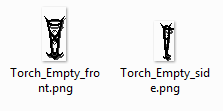
...and one when it's not empty:

As for the other walls, this one is drawn in CGame::drawWall(). We draw one ornate or the other depending on the existence
of an object stack associated to the wall:
else if (wall->getType() == eWallTorch)
{
//------------------------------------------------------------------------------
// torch holder
CObjectStack* stack = map.findObjectsStack(mapPos, playerSide);
CRect rect = walls.drawOrnate(image, tablePos, side, (stack != NULL ? ORNATE_TORCH_FULL : ORNATE_TORCH_EMPTY));
if (tablePos == CVec2(2, 3) && side == eWallSideUp)
mouse.addArea(eMouseAreaG_WallTorch, rect, eCursor_Hand, (void*)mapPos.x, (void*)mapPos.y, (void*)playerSide);
}
it for the mouse area.
Finally in CGame::update() we check the mouse area. Either we pick up the torch if our hand is empty, or if we are holding
a torch and the holder is empty, we "fill" it.
else if (clickedArea->type == eMouseAreaG_WallTorch)
{
CVec2 pos;
EWallSide side;
pos.x = (int)clickedArea->param1;
pos.y = (int)clickedArea->param2;
side = (EWallSide)((int)clickedArea->param3);
int type = mouse.mObjectInHand.getType();
CObjectStack* stack = map.findObjectsStack(pos, side);
if (type == 0 && stack != NULL)
{
mouse.mObjectInHand = stack->getObject(0);
map.removeObjectsStack(pos, side);
}
else if (type == 3 && stack == NULL)
{
stack = map.addObjectsStack(pos, side);
stack->addObject(mouse.mObjectInHand);
mouse.mObjectInHand.setType(0);
}
characters[interface.selectedChampion].updateLoad();
}
Last words
- The chest is a particular case. It's the only object that has an alternate image when it is in an alcove.
As there is no chest in the first level, I'll add it later. - In this level the alcove is a Vi altar that allows the player to resurrect a champion.
Obviously we haven't talked about the damages and death of the champions. So we'll see that later too. - Finally, I noticed there was a bug in the editor. At the beginning of this project, I copied some code from
another one that was in French, and I forgot to translate the "width" and "height" of the map in the map tab.
Now it is fixed.